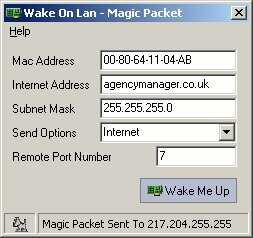Using the information from the other answers, I ended up creating a folder containing the following files:
connect.bat
mycomputer.rdp (remote desktop connection file)
sleep.exe (a little program to wait a specified number of milliseconds)
wolcmd.exe
So running connect.bat, wakes up my computer, waits 10 seconds, and then opens a remote desktop connection to it.
connect.bat contains the following:
ECHO OFF
CLS
WolCmd.exe 0011AA22BB33 10.1.255.255 255.255.0.0 7
ECHO Sleeping...
Sleep.exe 10000
ECHO Starting remote desktop connection
start mstsc.exe mycomputer.rdp
You can generate sleep.exe by saving the source below as sleep.cs, and compliling it using the C# compiler that comes with the .NET framework:
csc /out:sleep.exe c:\sleep.cs
Source for sleep.cs
using System;
using System.Threading;
namespace Sleep
{
class Program
{
static void Main(string[] args)
{
if (args.Length == 1)
{
int period = 0;
Int32.TryParse(args[0], out period);
Console.WriteLine("Sleeping for {0} ms", period);
Thread.Sleep(period);
}
}
}
}

2Don't newer motherboards have this feature? – Dalin Seivewright – 2012-02-09T14:28:59.863
@DalinSeivewright Yes they do-my newest dev machine does this automatically now :) – John Sibly – 2014-02-03T11:26:18.893